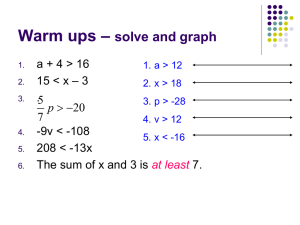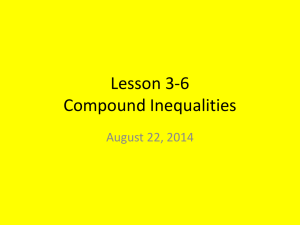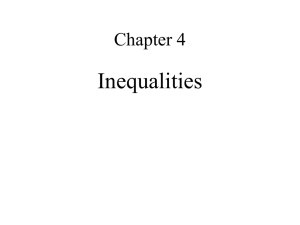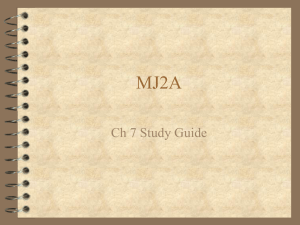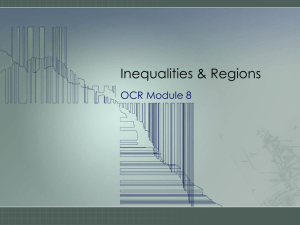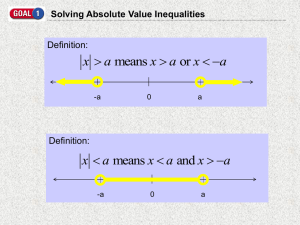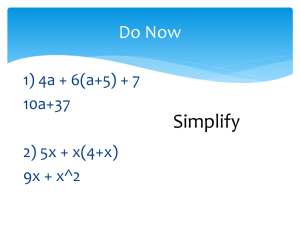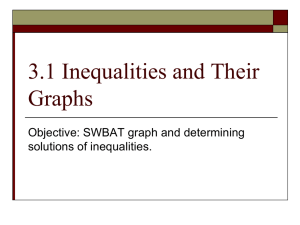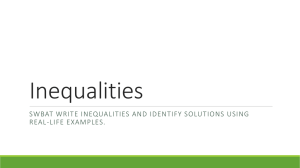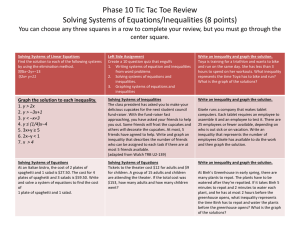Equations and Inequalities Day 9
advertisement
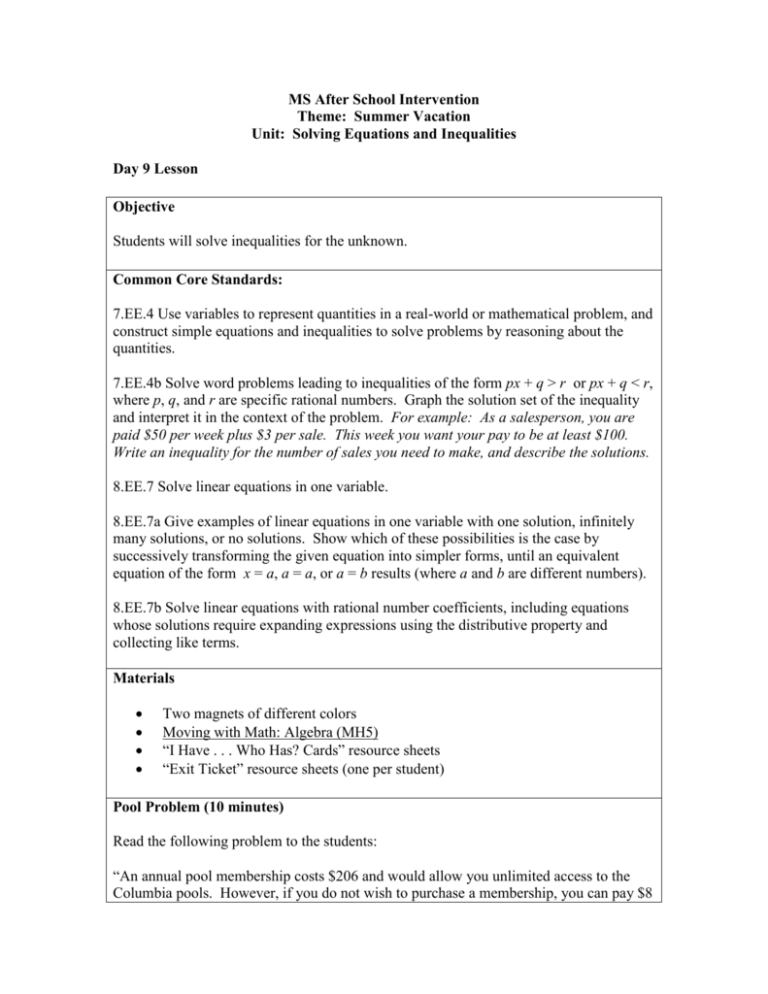
MS After School Intervention Theme: Summer Vacation Unit: Solving Equations and Inequalities Day 9 Lesson Objective Students will solve inequalities for the unknown. Common Core Standards: 7.EE.4 Use variables to represent quantities in a real-world or mathematical problem, and construct simple equations and inequalities to solve problems by reasoning about the quantities. 7.EE.4b Solve word problems leading to inequalities of the form px + q > r or px + q < r, where p, q, and r are specific rational numbers. Graph the solution set of the inequality and interpret it in the context of the problem. For example: As a salesperson, you are paid $50 per week plus $3 per sale. This week you want your pay to be at least $100. Write an inequality for the number of sales you need to make, and describe the solutions. 8.EE.7 Solve linear equations in one variable. 8.EE.7a Give examples of linear equations in one variable with one solution, infinitely many solutions, or no solutions. Show which of these possibilities is the case by successively transforming the given equation into simpler forms, until an equivalent equation of the form x = a, a = a, or a = b results (where a and b are different numbers). 8.EE.7b Solve linear equations with rational number coefficients, including equations whose solutions require expanding expressions using the distributive property and collecting like terms. Materials Two magnets of different colors Moving with Math: Algebra (MH5) “I Have . . . Who Has? Cards” resource sheets “Exit Ticket” resource sheets (one per student) Pool Problem (10 minutes) Read the following problem to the students: “An annual pool membership costs $206 and would allow you unlimited access to the Columbia pools. However, if you do not wish to purchase a membership, you can pay $8 each time you visit a Columbia pool. You want to know if the membership is worth the cost based on the number of times you plan on attending the pool this summer.” Have students discuss the problem in groups. Have them discuss the following questions, if they are having difficulty: 1. In what scenario would a $206 membership be a good investment? (Possible answers: when you go to the pool a lot, when you go to the pool more than 25.75 times, etc.) 2. Is there more than one possible solution to this problem? (If necessary, prompt the students to figure out the cost of attending the pool 10, 20, 30, and 40 times. The costs for these are $80, $160, $240, and $320 respectively.) 3. How could we set up a representation of this problem using a picture, manipulatives, algebra, or another method? (Students may set up an equation rather than an inequality. Have them discuss how this problem is different.) Which Number is Larger? (15 minutes) Draw a number line at the top of the board from –10 to 10. Place a different color magnet on the numbers 2 and 8. Ask the students which number is larger and why. (8 because it is farther to the right.) Assign the 8 to the left half of the room and the 2 to the right half. Place the appropriate inequality symbol between the two groups to show that 8 > 2. Next, ask the students to add 2 to their number in their heads. Have a student on the left half of the room move their magnet. Have a student on the right half move their magnet. Discuss what happened. (Both moved to the right 2, the left half of the room still has the larger number, 10 is larger than 4, they are the same distance apart, etc.) Tell the students to subtract 7 from their numbers. Have the students move their magnets. Discuss what happened. (Both moved to the left 7, the left half of the room still has the larger number, 3 is larger than –3, they are the same distance apart, etc.) Have the students multiply their numbers by 3 and move their magnets. Discuss what happened. (The left half of the room still has the larger number, 9 is larger than –9, the numbers are now farther apart, etc.) Have the students cut their numbers in half (divide by 2). Discuss what happened. (The left half of the room still has the larger number, 4 is bigger than –4.5, the numbers are now closer together, etc.) Have the students multiply their numbers by –2. Discuss what happened. (The right half of the room now has the larger number, –9 is smaller than 9, the inequality symbol needs to flip.) Have the students divide by –3. Discuss what happened. (The left half of the room has the larger number again, 3 is bigger than –3, the inequality symbol must flip again.) Have the students discuss the concepts they discovered and how they relate to inequalities. When they perform an operation to two unequal numbers, what happens? (When you add, subtract, multiply, or divide by a positive, the larger number stays larger. When you multiply or divide by a negative, the larger number becomes smaller and the inequality symbol needed to flip.) Solving One-Step Inequalities (15 minutes) Complete the Introductory Activities on page 54 and on page 55 of Moving with Math: Algebra (MH5). Have the students complete several of the practice problems and graph their solutions. Have students discuss how they might solve a problem requiring multiplication or division by a negative. Remind them of the “Which Number is Larger?” activity and what happened to the inequality symbol in this scenario. Have the students try a few onestep problems that require multiplication or division by a negative. I Have . . . Who Has? (20 minutes) Separate the class into groups of three or four. Give each group a deck of “I Have . . . Who Has?” cards. Have someone in the group shuffle and deal the cards until they are all disseminated. Have the student to the right of the dealer start by reading one of their questions. For example, they may say “I have 2 x 6 , who has the graph of x > 3?” The student should then place their question card on the table. Whoever has the corresponding graph should place their graph on top of this card and then read one of their question cards. Play continues until all inequalities have been matched with their graphs. Revisiting the Pool Problem (15 minutes) Re-read the pool problem from the beginning of the lesson. Discuss as a class how they might represent and solve this scenario algebraically. (Solution: 8x < 206, x < 25.75) Have the students graph this solution and discuss what the solution means in terms of the problem. Be sure to talk about the following: 1. If you go to the pool 25 times, should you get a membership? 2. If you go to the pool 26 times, should you get a membership? 3. Can you go to the pool 25.75 times? Have the students keep all of this in mind as you read the following problem: “After deciding to purchase a pool membership, you want to buy an iPod nano to use while you walk to the pool each day. The iPod you want costs $179. You already have $35 saved. If you get paid $20 every time you baby-sit your cousins, how many nights will you have to baby-sit in order to have more than enough money to buy the iPod?” Discuss why this is different from the one-step inequality in the original pool problem. Have the students set up, solve and graph the inequality in their groups. As a class discuss what the solution means in terms of the problem. Solution: 20x + 35 > 179 x > 7.2 You would have to baby-sit at least 8 nights to be able to afford the iPod. Discuss why 7 nights would not be enough. Closure (5 minutes) Discuss the following questions, as a class: 1. How is solving an equation similar to solving an inequality? 2. How is solving an equation different from solving an inequality? Be sure to bring up the differences in solution sets (equations have one solution, while inequalities have a range of solution). In addition, be sure to discuss the rules for solving inequalities when multiplying/dividing by negatives. Exit Ticket (10 minutes) Have students complete and turn in the exit ticket. Check for accuracy to see how well students mastered the lesson. Use the information to help inform instruction for Day 10. Exit Ticket: Solve each inequality and graph the solution. Show work and/or explain what you did to find the answer. 1. 2. 8m 3 13 x 1 4 3 Solutions: 1. m > 2 2. x > –9 I Have . . . Who Has? Cards 5x 15 2x 10 x 2 3 x 1 3 4x 16 x 1 4 3 x 9 x72 Exit Ticket Exit Ticket: Solve each inequality and graph the solution. Show work and/or explain what you did to find the answer. 1. 8m 3 13 2. x 1 4 3
